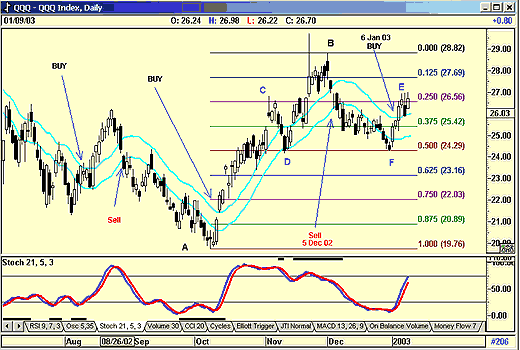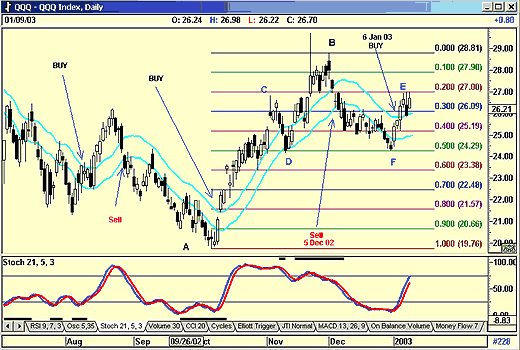
HOT TOPICS LIST
- MACD
- Fibonacci
- RSI
- Gann
- ADXR
- Stochastics
- Volume
- Triangles
- Futures
- Cycles
- Volatility
- ZIGZAG
- MESA
- Retracement
- Aroon
INDICATORS LIST
LIST OF TOPICS
PRINT THIS ARTICLE
by Koos van der Merwe
Markets have moved to decimals. Is W.D.Gann's Rule of Eight still effective?
Position: Buy
Koos van der Merwe
Has been a technical analyst since 1969, and has worked as a futures and options trader with First Financial Futures in Johannesburg, South Africa.
PRINT THIS ARTICLE
GANN
The Rule of Eight
01/13/03 11:50:24 AMby Koos van der Merwe
Markets have moved to decimals. Is W.D.Gann's Rule of Eight still effective?
Position: Buy
| One of W.D. Gann's techniques for determining projected support and resistance levels was the Rule of Eight. He would look for two major pivot points, and divide the distance between them into eight sections. He believed that because market prices were quoted in eighths, it was natural for prices to drift to these levels, and he was not wrong. Historical studies of charts show that prices did indeed tend to find support or resistance at these levels |
| Figure 1 shows the QQQ daily index. In the chart I have drawn eight zones of equal distance between the major pivot points A and B. Note how C and D formed a support and resistance level at the 0.25 (25%) and 0.5 (50%) levels respectively. You could therefore use the Rule of Eight to forecast that in a down move, the QQQs would probably find support at the 50% level, which it did. You could also forecast that the 25% level will be a strong resistance level, which it is, and that any break through this level, will find resistance at the 12.5% (0.125) level at $27.69. With a rising stochastic, this is a very real probability. |

|
| Figure 1: Rule of Eight. Obsolete? |
| Graphic provided by: AdvancedGET. |
| |
| In today's market however, where all prices are quoted in decimals, I believe that the Rule of Eight is like the dinosaur-- effective in its time, but now obsolete. To me, it is logical to assume that rather than using eighths to determine support and resistance levels, tenths should be used, hence the "Rule of Tens." |
The following chart is the same chart, but with the distance between the pivot points divided into tenths. Figure 2: Rule of Ten. |
| The first thing you notice about the chart is the highs formed by the price at 'E' is spot on the 0.20 (20%) level, whereas on the Rule of Eight's chart, it exceeded the 0.25 (25%) level, being a bit 'fluffy.' Any future projection therefore should also be 'fluffy' whereas using the Rule of Ten, a projection would be more definite. Does this mean that Gann's Rule of Eight no longer applies? I believe that the Rule of Eight is now obsolete. Whether the Rule of Ten will be as effective from now forward as the Rule of Eight was in the past, is something I will have to find out in the future. In the meantime, my next resistance level for a rising QQQ is $27.90, the 10% level, and not the $27.69 level as suggested by the Rule of Eight. |
Has been a technical analyst since 1969, and has worked as a futures and options trader with First Financial Futures in Johannesburg, South Africa.
| Address: | 3256 West 24th Ave |
| Vancouver, BC | |
| Phone # for sales: | 6042634214 |
| E-mail address: | petroosp@gmail.com |
Click here for more information about our publications!
Comments
Date: 01/14/03Rank: 3Comment: Maybe Mr. Singer didn t realize that WD Gann also specified that some Commodities Markets were calculated by Tenths. Stocks may fit this bill, but not all.
Thank you J. L. Mason independant
Date: 01/14/03Rank: 5Comment:
Date: 01/14/03Rank: 2Comment:
Date: 01/14/03Rank: 4Comment:

|

Request Information From Our Sponsors
- StockCharts.com, Inc.
- Candle Patterns
- Candlestick Charting Explained
- Intermarket Technical Analysis
- John Murphy on Chart Analysis
- John Murphy's Chart Pattern Recognition
- John Murphy's Market Message
- MurphyExplainsMarketAnalysis-Intermarket Analysis
- MurphyExplainsMarketAnalysis-Visual Analysis
- StockCharts.com
- Technical Analysis of the Financial Markets
- The Visual Investor
- VectorVest, Inc.
- Executive Premier Workshop
- One-Day Options Course
- OptionsPro
- Retirement Income Workshop
- Sure-Fire Trading Systems (VectorVest, Inc.)
- Trading as a Business Workshop
- VectorVest 7 EOD
- VectorVest 7 RealTime/IntraDay
- VectorVest AutoTester
- VectorVest Educational Services
- VectorVest OnLine
- VectorVest Options Analyzer
- VectorVest ProGraphics v6.0
- VectorVest ProTrader 7
- VectorVest RealTime Derby Tool
- VectorVest Simulator
- VectorVest Variator
- VectorVest Watchdog
